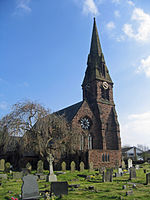Vale Royal Abbey is a former medieval abbey and later country house in Whitegate, England. The precise location and boundaries of the abbey are difficult to determine in today's landscape. The original building was founded c. 1270 by the Lord Edward, later Edward I, for Cistercian monks. Edward had supposedly taken a vow during a rough sea crossing in the 1260s. Civil wars and political upheaval delayed the build until 1272, the year he inherited the throne. The original site at Darnhall was unsatisfactory, so was moved a few miles north to the Delamere Forest. Edward intended the structure to be on a grand scale—had it been completed it would have been the largest Cistercian monastery in the country—but his ambitions were frustrated by recurring financial difficulties.
Early during construction, England became involved in war with Wales. As the treasury was thus in need of resources, Vale Royal lost all of its grants, skilled masons and builders. When work resumed in the late 13th century, the building was considerably smaller than originally planned. The project encountered other problems. The abbey was mismanaged and poor relations with the local population sparked outbreaks of violence on a number of occasions. In one such episode in 1336, the abbot was killed by a mob. Internal discipline was also frequently bad; in the 14th century the monks were often accused of serious crimes including rape, and the abbots were seen as protecting them. The abbey was devastated at least twice: in the early 1300s a fire destroyed the entire monastic grange, and in 1359—soon after building work had recommenced under the patronage of Edward the Black Prince—a great storm caused the collapse of the massive nave.
Vale Royal was closed in 1538 by Henry VIII during his dissolution of the Monasteries campaign, although not without controversy. In the course of the proceedings, the abbot was accused of treason and murder, and he in turn accused the King's men of fraudulently forging the abbot's signature on essential legal documents but the abbey's closure was inevitable, and its estates were sold to a member of the local Cheshire gentry, Thomas Holcroft. Holcroft pulled much of it down (including the church), although he incorporated some of the cloister buildings into the new mansion he built on the site in the 1540s. This was subsequently considerably altered and extended by successive generations of Holcrofts. Vale Royal came into the possession of the Cholmondeley family during the early 1600s, and remained the family seat for more than 300 years.
The Cholmondeley family remodelled the exterior during the 18th century, and Thomas Cholmondeley carried out extensive work in the early 1800s. Substantial alterations were carried out under the auspices of Edward Blore in 1833 and by John Douglas from 1860. Sold soon after the Second World War, it was turned into a private golf club. The building remains habitable and contains parts of the medieval abbey, including its refectory and kitchen. The foundations of the church and cloister have been excavated; Vale Royal Abbey, a scheduled monument, is listed in the National Heritage List for England as a Grade II* listed building.








